My transistor is overheating when the MCU turns the fans on. How do I fix this?

simulate this circuit – Schematic created using CircuitLab The MCU has an output of 12V.
My transistor is overheating when the MCU turns the fans on. How do I fix this?

simulate this circuit – Schematic created using CircuitLab The MCU has an output of 12V.
Another simple way to look at this is just by resistance ratio and power ratio.
Consider Rja= 200'C/W lets consider 1/4W max for a 50'C junction temperature rise above ambient.
Loss/Load= 0.25/3.6W x100% = 7%
Load = 12V/0.3A= 40 ohms
Loss = 7% of 40 ohms = 2.8 Ohms
BLDC fans have a steady-state (SS) proportional current above stall speed so may be considered like a SS resistive load.
How do you choose ?
2N3904 TO-92 ON SEMI fig2 : Rce= 0.12V @ 100mA Max @ hFE=10 ( BAD choice , not rated for 300 mA, only 200 mA and you should have heat margin so derate 50%)
PN2222A TO-92 can be made to work with Rce <=2 ohms but a power transistor or low RdsOn power FET is clearly a better choice
To reach Vce(sat) rating and it’s rated switching current the typical device must use Ic/Ib=10 unless using a super beta type transistor.
For the 300mA fan that means 30mA. You didn’t state what your MCU p/n is and that is critical. That would be the absolute max current also for the typical 20mA LED
The 1k at best can only drive 1mA from 12V. Try stating the actual specs and consider some from 5V like 5-2.1V-0.7V=Vr=2.2V drop across resistor and that means 2.2V/30mA= 73 Ohms and if it is a 50mOhm CMOS driver that means adding only 23 Ohms , so either give MCU specs or try changing 1k to something between 23 and 100 Ohms.
When driven with low current the transistor is no longer in saturation and at Vce=6V the transistor will have risen to 50% of the power drawn by the fan. Meaning the 12V*300mA 3.6W fan will be drawing 150mA or 1.8W the same as the transistor probable only rated for 0.5W at 120’C (Too tired to look up) (200’C/W)